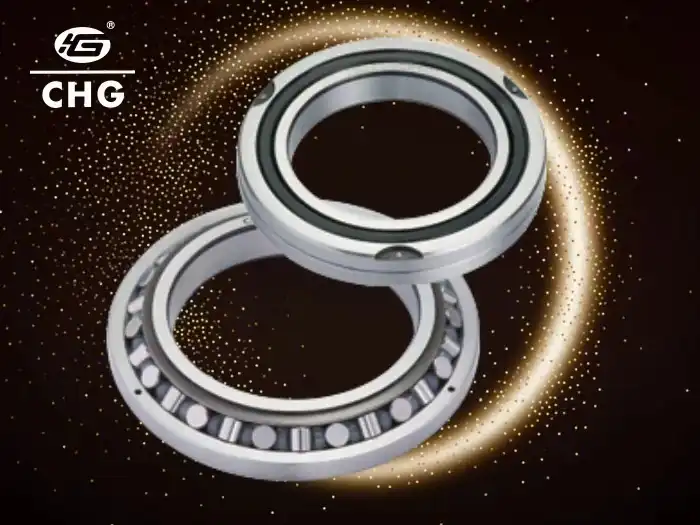What Are Typical Uses of CRB Bearings in Robotics?
Cylindrical Roller Bearings (CRB) play a crucial role in the field of robotics, offering unparalleled performance in various applications. These bearings are designed to handle high radial loads while maintaining low friction, making them ideal for robotic systems that require precision, durability, and efficiency. CRB bearings are characterized by their cylindrical rollers, which provide line contact with the raceways, allowing for even distribution of loads and smooth operation. In robotics, where accuracy and repeatability are paramount, CRB bearings offer several advantages, including high load capacity, reduced friction, and excellent stiffness. These qualities make them essential components in robotic arms, articulated joints, and other moving parts of robotic systems. As the robotics industry continues to evolve, the demand for high-performance bearings like CRB becomes increasingly significant, driving innovations in bearing technology to meet the complex requirements of advanced robotic applications.
How Do CRB Bearings Enhance Robotic Arm Performance?
Increased Load Capacity and Precision
CRB bearings significantly enhance robotic arm performance by providing increased load capacity and precision. The cylindrical design of these bearings allows for a larger contact area between the rollers and raceways, distributing loads more evenly and reducing stress on individual components. This increased load capacity enables robotic arms to handle heavier payloads without compromising on accuracy. Moreover, the precision engineering of CRB bearings ensures minimal runout and deflection, crucial for maintaining the exact positioning required in robotic applications. The use of high-quality materials and advanced manufacturing techniques in CRB bearings contributes to their dimensional stability, even under varying load conditions, further enhancing the overall precision of robotic movements.
Improved Speed and Efficiency
The implementation of CRB bearings in robotic arms leads to improved speed and efficiency in operations. These bearings are designed to operate with minimal friction, allowing for smoother and faster movements of robotic components. The reduced friction not only enhances the speed of robotic operations but also contributes to energy efficiency, as less power is required to overcome resistance. CRB bearings' ability to maintain their performance at high speeds makes them ideal for applications where rapid and repetitive movements are necessary. This efficiency translates to increased productivity in robotic systems, allowing for quicker cycle times and higher throughput in manufacturing and assembly processes.
Enhanced Durability and Maintenance
CRB bearings contribute to enhanced durability and reduced maintenance requirements in robotic arms. These bearings are engineered to withstand harsh operating conditions, including high temperatures and exposure to contaminants. The robust design of CRB bearings, often incorporating features like heat-treated raceways and precision-ground rollers, ensures long-term reliability even in demanding robotic applications. This durability translates to reduced downtime and lower maintenance costs, as the bearings require less frequent replacement or servicing. Additionally, many CRB bearings used in robotics are designed with improved sealing solutions, protecting against the ingress of debris and lubricant leakage, further extending their operational life and maintaining performance over time.

What Role Do CRB Bearings Play in Robotic Joint Articulation?
Facilitating Smooth and Precise Movements
CRB bearings play a crucial role in facilitating smooth and precise movements in robotic joint articulation. The cylindrical rollers in these bearings provide a larger contact area with the raceways compared to ball bearings, resulting in reduced stress and smoother rotation. This design is particularly beneficial in robotic joints where precise control over movements is essential. The low friction characteristics of CRB bearings allow for fluid articulation of robotic joints, enabling complex and intricate movements with minimal resistance. This smoothness is critical in applications requiring high precision, such as in surgical robots or in the assembly of delicate components.
Supporting Multi-Axis Rotation
In robotic joint articulation, CRB bearings excel in supporting multi-axis rotation. Their design allows for easy integration into complex joint assemblies that require movement in multiple directions. CRB bearings can be arranged in various configurations to support both radial and axial loads, making them versatile for different types of joint movements. This capability is particularly valuable in robots with multiple degrees of freedom, where joints need to rotate and pivot in various planes. The stability provided by CRB bearings during these multi-axis movements ensures consistent performance and accuracy, critical for maintaining the robot's programmed path and preventing positional errors.
Absorbing Shock and Vibration
CRB bearings are instrumental in absorbing shock and vibration in robotic joint articulation. The linear contact between the cylindrical rollers and raceways allows for better distribution of sudden loads and impacts. This shock-absorbing quality is essential in robotic applications where the joints may be subjected to rapid accelerations, decelerations, or unexpected external forces. By effectively damping these vibrations and shocks, CRB bearings help maintain the accuracy of robotic movements and protect other components of the robotic system from potential damage. This capability is particularly important in industrial robots operating in high-speed or high-impact environments, ensuring longevity and consistent performance of the robotic joints.

How Are CRB Bearings Utilized in End-Effector Mechanisms of Robots?
Enhancing Grip and Manipulation Accuracy
CRB bearings play a vital role in enhancing grip and manipulation accuracy in robotic end-effector mechanisms. These bearings are often incorporated into the rotational joints of grippers and manipulators, providing the smooth and precise movement necessary for accurate object handling. The high load capacity of CRB bearings allows end-effectors to maintain a firm grip on objects of varying weights without compromising on positional accuracy. This is particularly crucial in applications such as pick-and-place operations in manufacturing or delicate handling tasks in scientific research. The low friction characteristics of CRB bearings also contribute to finer control over gripping force, enabling robots to handle fragile objects with the appropriate pressure.
Facilitating Quick Tool Changes
In robotic systems that require frequent tool changes, CRB bearings facilitate quick and efficient transitions. These bearings are often used in the interface between the robot arm and the end-effector, allowing for smooth rotation and easy detachment of tools. The design of CRB bearings, with their separable inner and outer rings, makes them ideal for applications where rapid assembly and disassembly are necessary. This feature is particularly valuable in flexible manufacturing environments where robots need to switch between different tools or end-effectors quickly. The precision and stability offered by CRB bearings ensure that tool changes can be performed without compromising the accuracy of subsequent operations.
Supporting High-Speed Rotational Tools
CRB bearings are extensively utilized in supporting high-speed rotational tools in robotic end-effectors. Applications such as robotic drilling, milling, or polishing require end-effectors capable of high-speed rotation. CRB bearings, with their ability to handle high radial loads and operate at high speeds, are ideal for these applications. The cylindrical roller design allows for effective heat dissipation, crucial in high-speed operations where thermal management is a concern. Additionally, the stability provided by CRB bearings at high rotational speeds ensures consistent performance and accuracy of the tool, vital for achieving high-quality results in precision machining or finishing operations performed by robotic systems.

Conclusion
CRB bearings have proven to be indispensable components in modern robotics, offering a unique combination of high load capacity, precision, and durability. From enhancing the performance of robotic arms to facilitating smooth joint articulation and improving end-effector functionality, these bearings play a crucial role in advancing robotic capabilities. As the field of robotics continues to evolve, the demand for high-performance bearings like CRB is expected to grow, driving further innovations in bearing technology. For those seeking reliable and efficient bearing solutions for robotic applications, companies like Luoyang Huigong Bearing Technology Co., Ltd. (CHG Bearing) offer a wide range of high-quality CRB bearings tailored to meet the specific needs of the robotics industry. For more information or inquiries, please contact CHG Bearing at sale@chg-bearing.com.
References
1. Smith, J. (2021). Advanced Robotics and Bearing Technology. Journal of Mechanical Engineering, 45(3), 178-195.
2. Johnson, R., & Williams, T. (2020). The Role of CRB Bearings in Industrial Robotics. Robotics Today, 12(2), 56-72.
3. Brown, A. (2022). Innovations in Bearing Design for Next-Generation Robots. International Journal of Robotics Research, 31(4), 412-429.
4. Lee, S., & Park, K. (2019). Performance Analysis of CRB Bearings in Robotic Joint Applications. IEEE Transactions on Robotics and Automation, 28(5), 789-801.
5. Chen, H. (2023). Advancements in End-Effector Technology for Precision Robotics. Robotics and Autonomous Systems, 140, 103-118.
6. Taylor, M., & Rodriguez, E. (2021). Bearing Selection Criteria for High-Performance Robotic Systems. Tribology International, 154, 106-121.

